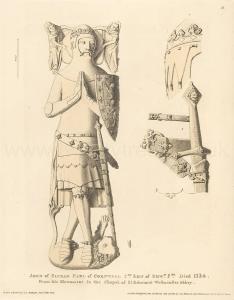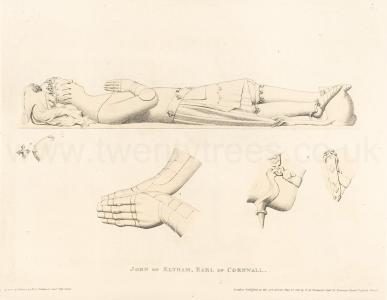Effigy of John of Eltham, Earl of Cornwall
Effigy of John of Eltham, Earl of Cornwall is in Monumental Effigies of Great Britain.
John of Eltham 1st Earl Cornwall
WAS the second son of Edward the Second by his Queen Isabella (age 42), and was horn at the Palace of the English Kings at Eltham in Kent [Map], on the Feast of the Blessed Virgin's Assumption 1316. In the second year of the reign of his elder brother, Edward III (age 24) he was created Earl of Cornwall. In the following year, the King going to France to do homage for the Dukedom of Aquitaine, he was appointed his Lieutenant for the Kingdom, as he was also on the King's expedition into Scotland in 1330. In the course of the above periods he had grants of numerous Lordships from the Crowna, the town of Lostwithiel (in the neighbourhood of Restormel Castle, the principal seat of the Earls of Cornwall in the County), all the wreck, port dues, issues, and profits of the district, the farm of the City of Exeter, the stannaries, and coinage or customs on stamping the tin in the County of Devon. In 1333 and 1334 he was with King Edward III in his expeditions into Scotland, and died at Berwick-upon-Tweed [Map] in October of the latter year. About the festival of Christmas, the King, with the Archbishop of Canterbury, returned out of Scotland to celebrate his obsequies in the Abbey Church of Westminster, where he was interred on the south side of the Choir. The Prior and Convent claimed £400 in lieu of his horse and armour, which, according to the custom, should have been presented as an offering at the altar of their Church. John of Eltham was but twenty-eight years of age at his death, and was never married. Various matches were proposed for him, as with Joan, the daughter of the Earl of Eu; Mary, the daughter of the Earl of Blois; Mary (age 18), daughter of Ferdinand Lord Lara in Castile, which last proposal came to a formal contract, rendered abortive bv his demise.


Nothing can be finer in its way than the sculpture of this effigy. There is no departure from the very usual recumbent attitude, the hands raised in prayer and the legs crossed; but there is a most beautiful simplicity in the whole figure, while the details of the arms and drapery are marked with elegant precision.
Details. Plate I. Portion of the head, with the ducal crown and mantelet depending from the lace; ornaments on the sword belt, handle, and scabbard of the sword; scalloped border of an aqueton, or some defence under the surcoat. Plate II. Ornaments on the top of the hood, or basinet, whichever it may be; plating of the gauntlets, pryck spur and leathers, plates on the solerette, buckle of the spur, with tongue of the strap.
Note a. See Dugdaie's Baronage, vol. 1. p. 207.

